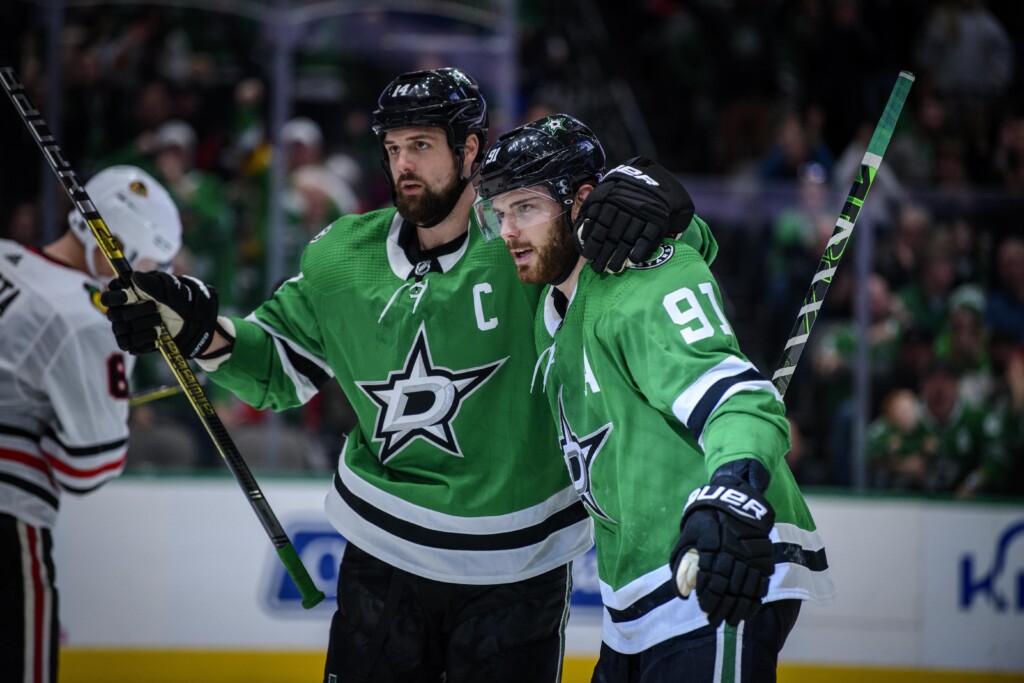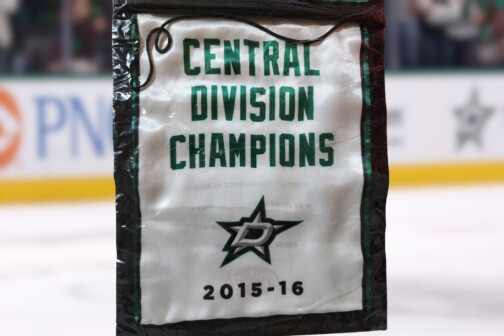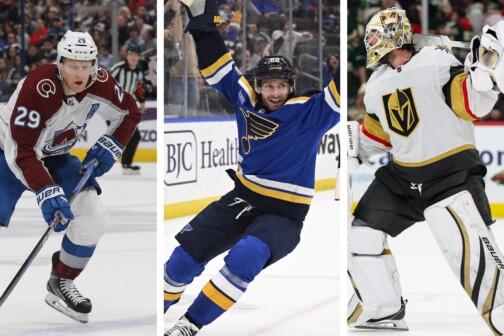According to former Stars CEO Jim Lites, the infamous “F**king Hores**t” rant he directed at Jamie Benn and Tyler Seguin in 2019 was prompted by none other than owner Tom Gaglardi. As Lites told it to Sean Shapiro of The Athletic, during the first half of the 2018-19 season, it wasn’t uncommon for him to get five “WTF” texts in a game from Gaglardi, many of them related to the perceived underachievement of his two stars. So it makes a certain kind of sense that the knee-jerk reaction of Stars fans to Gaglardi’s recent interview on the Cam and Strick Podcast, in which he brought up their lack of production and a need for improvement, was to treat it like a sequel nobody wanted.
For the record, this isn’t that. Not even close. But I still found the implications problematic. The Stars are trying to be a contender, and nothing about Gaglardi’s comments strike the tone of a man who believes they are.
First, though, some mythbusting: Gaglardi didn’t rip his players. From the beginning, his comments about Benn and Seguin go beyond being diplomatic. He actively defended them. He highlights Benn’s hockey strengths that transcend the stat sheet, and he directly attributes Seguin’s struggles to injury, not something the 30-year-old is doing wrong. These are nice gestures.
The problem is how the comments come off. It’s worth remembering that Gaglardi is repeating what he said in July when, unprompted, he once again made a point to highlight the players’ low points totals. The tone in that one fell somewhere between 2019 and last week, but because his opinion on Benn and Seguin’s performance has been public record for a while, every assessment, no matter the prompting or the message, feels derived from Lites’ diatribe. It always achieves the effect of pointless needling.
Which is why it’s time to stop talking about the two of them. Not just Gaglardi–everyone. Granted, nobody this side of the Stars owner harbors any real expectation of them being 80-point players again, but every discussion creates some expectation that they should be close to that, and only a time machine will boost their point totals near what they were once capable of.
In their primes, Benn and Seguin weren’t just the team’s lifeblood; they were damn near peerless throughout the NHL. From 2013 to ’19, they were a top-10 duo in scoring, with a percentage of team goals they had a hand in exceeding even the Capitals’ indomitable (and Cup-winning) Alex Ovechkin and Nicklas Backstrom. But that run began nine years ago. Benn and Seguin are underperforming as they age because that’s what happens when players age. Players retain, on average, roughly 90 percent of their scoring through age 29 and only 70 to 80 percent of it through the ages of 32 and 33. Benn and Seguin fall exactly within that spectrum, and neither should reasonably be expected to age at close to an average rate, given the former’s bruising style of play and the latter’s injury history.
And because we’re talking expectations, let’s turn the tables on management for a moment. I think that’s only fair. After all, if Dallas wants to hold Benn and Seguin accountable for not doing more for Dallas in their 30s, why shouldn’t Benn and Seguin hold Dallas accountable for not doing more for them when they were in their 20s?
During those six seasons, the Stars’ goaltending ranked 20th at even strength per Evolving-Hockey. You can pin some of that on the revolving door at goaltender after Kari Lehtonen’s tumultuous decline–Ben Bishop didn’t show up until 2017, and the intervening years were bleak–but Dallas was 20th in goals against and 20th in expected goals against, suggesting it didn’t have a goaltending problem so much as one with the entire defense. Which goes a long way toward explaining why, at the absolute height of their star duo’s powers, the Stars made the playoffs in only three of those six seasons. Benn and Seguin weren’t the ones who let three-quarters of the team’s top four defensemen hit the open market in 2016, and they didn’t hire Ken Hitchcock in 2017, who changed the identity of the team by swapping old problems (a lack of defense) for new ones (a lack of scoring).
The Stars never did enough to support Benn and Seguin during their apex, and now it’s too late. But while their time as the focus of the front office’s project has passed, their time as valuable pieces certainly hasn’t.
For instance, almost every forward trio involving Benn at center (and without Seguin) has been extremely effective. In fact, there’s a common theme when it comes to their effectiveness. Give them better linemates, a line with chemistry or keep them away from one another, and they still play effective hockey. Notice the common denominator with the worst line combinations?
I’d argue that this is the crux of their struggle. They spent all of their time together at their best, and it’s no secret why: Seguin had the legs and off-puck movement to get Benn into position to shoot, and Benn had the power in transition and forechecking ability (which he still has) to put Seguin in a position to shoot.
Those skills have mostly faded, yet Dallas cannot give up the ghost of forcing them to spend time together at their worst. This should be the focus for Gaglardi: how his front office and coaching staff can maximize the pair as the players they are today instead of lamenting who they used to be. It should be about influencing performance with effective lines that tilt control of the puck in Dallas’ favor rather than engineering raw goal totals. You can guarantee the former. You can’t the latter. Maybe the key is to surround them with talents who can mimic parts of their respective games. Find Benn a player with speed who can shoot like Seguin—it’s probably not a coincidence Benn has shown chemistry with Denis Gurianov—and find Seguin a player who can transition through the neutral zone like Benn. Recent addition Mason Marchment profiles quite similarly to Benn in his prime, and Wyatt Johnston sketches out like Seguin in the way he shortens the ice for quick puck movement.
Ultimately, if we can agree that Benn hasn’t been given time to grow into a role he has shown evidence he can excel at, that Seguin still needs time to recover from relearning how to walk, that Dallas wasted their prime years with suboptimal support, and that the team hasn’t experimented with better alternatives for a sustainable future—well, then whose performance should we really be complaining about?
I don’t think Gaglardi’s recent comments are about an owner being “tough” on his stars. I think they’re about a philosophical debate. Who is responsible for performance? Is it on the individuals or the group? I would argue both. What did Benn and Seguin have to do with the lack of urgency to fix the goaltending issues in 2015? To restore the blueline in 2017? To improve the offense in 2019? To kick it into high gear in 2021? I ask these questions because I have the sneaking suspicion we wouldn’t hear a word about the performance of Benn and Seguin, for example, they had won Dallas a Stanley Cup.
Teams that win the Cup aren’t barking at their stars to do better. They’re using modern, data-driven approaches to find an edge wherever they can. Teams trying to claw their way out of the NHL basemen, like the Buffalo Sabres, have followed such a plan, and because everyone is on the same page, players are benefiting on the ice. When you look at players around the league who are experiencing a renaissance, it’s because teams are being scientific about positioning. Matt Duchene didn’t go from 42 points to 86 by accident; Nashville shifted him to the wing. Jeff Skinner didn’t luck into becoming a 30-goal scorer again after three cold seasons; Buffalo tried the veteran on a line with a young gun and a power forward. Recall that Joe Pavelski’s first season in Dallas was hardly anything to write home about. What changed? He was sandwiched between two of the game’s most dynamic young players instead of Alex Radulov and Mattias Janmark.
The 2020 Cinderella run to the Cup Final notwithstanding, Dallas hasn’t come close to being a contender. Since 2013, the Stars have an average win percentage of .560. Top-10 teams average a win percentage of .600 or higher. Wasting what’s left of Benn and Seguin isn’t the difference between Dallas and those contenders–this team now belongs to Jason Robertson, Roope Hintz, and Miro Heiskanen– but it is emblematic of the gap in resourcefulness, among other things.
I do believe there’s room for optimism. Pete DeBoer is a good coach, Jim Nill has pulled Dallas out of a bigger hole than the one he stepped in, and the kids are better than alright. But the future isn’t built with nostalgia, and shaming Benn and Seguin, however carefully worded, won’t be a learning tool. We already know why they’re not as good as they used to be: power forwards don’t age well, and centers who have to learn how to walk again deserve time. How about saving the next rant for the players or personnel who don’t have excuses or have yet to give it their all?
Get the ItList Newsletter
Author







